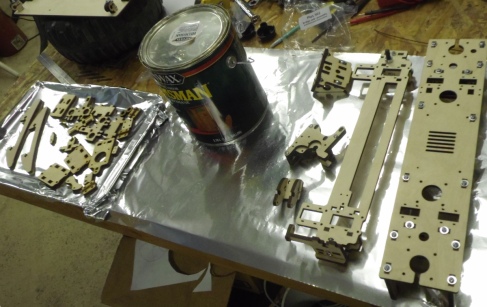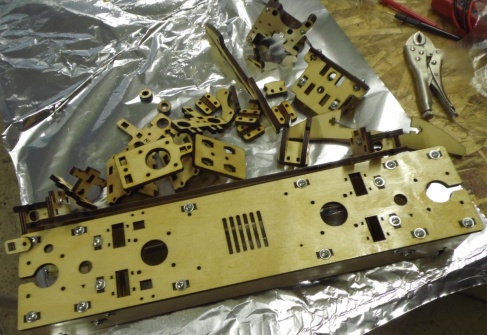One whole generation of do-it-yourself 3D printers (from 2009’s Makerbot Cupcake to 2012’s Printrbot Plus) are made from laser-cut wood, held together with small screws and bolts. There are good things about this: wood is cheap, light, stiff, and environmentally friendly, and laser cutting is fast and precise. But wood is fairly weak and splinter-prone, wood structures warp with humidity changes, and the bolts holding everything together tend to vibrate loose when printing.
You can improve each of these drawbacks by dunking your wooden printer assemblies into polyurethane. Dunking lets the polyurethane soak into the fibers, which strengthens them somewhat. It reduces the rate moisture can diffuse in, reducing warping with humidity. And polyurethane soaked onto the threads of the screws keeps them from vibrating loose, but is still removable for servicing.
Last month I built up a Printrbot Plus from a kit, and tried coating the wood. I dunked each of the major assemblies (the base, bridge, extruder, and printbed) after adding screws and nuts, but before adding any electronics or linear bearings. Here are the parts ready to go in: assemblies are on the right; loose parts on the left.
Here they are after coating in polyurethane. I had to brush the poly onto the top deck, since it’s too big to fit in the 1 gallon can, but everything else got dunked on both ends, and then brushed into the middle. This process was pretty messy, so I wore rubber gloves.
This “quick drying” poly still took about a day to stop being tacky and smelly; the solvent stench is so strong that I wore an activated carbon respirator while dunking and painting. Total poly consumption was tiny, 50 mL or less, although you need a much bigger container to allow dunking. There doesn’t seem to be any substantial dimensional change, and everything assembled fine. The poly brought out some beautiful chatoyancy glinting within the wood, an unexpected benefit, and added a nice warm glow to the wood.
This printer has been run hard for several dozen prints and a few cumulative days of continuous printing since then, and haven’t had a screw back out yet!


The printrbot uses 5 layer plywood which is not, in general, weak or splinter prone or subject to warpage with humidity changes. That’s why plywood was invented and that’s why it is used in the printrbot.
Polyurethane will not strengthen wood but will coat it to add a protective finish. It won’t change the dimensions either because it is plywood which is already dimensionally stable.
Polyurethane is best applied in multiple thin coats. This is why the ‘quick drying’ poly took so long to dry! Dunking is just a plain lazy way to do it. You should consider wipe on poly if you don’t want to brush each piece individually.
The warm glow you got is well, because, wood is beautiful.
Personally I finished the wood first with some linseed oil because it’s more natural, safer to apply, though it is not as good as protective finish as your plastic coating.
Comment by SteveR — January 4, 2013 @ 10:17 am